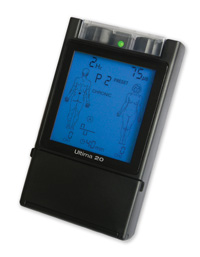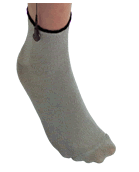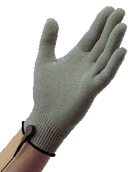Peripheral Neuropathy
No cure, but now there is help to alleviate the pain!
While there is no cure for neuropathy, using the Ultima 20 with the
conductive Socks and/or Gloves has helped thousands of patients
alleviate their pain significantly! The Ultima 20 works by stimulating
your nerves, helps soothe irritated nerves, wakes up numb nerves, and
restores the natural balance of your nervous system.
The
ULTIMA 20 in conjunction
with
conductive garments uses
electrical impulses sent through the skin to the nerves to modify your
pain perception. In most patients it is highly effective in reducing,
even eliminating the pain. In most patients the reduction or elimination
of pain lasts longer than the actual period of stimulation. The
ULTIMA 20
overrides the pain signal to the brain by sending a comfortable
electronic pulse, "tricking" the brain into thinking there is no pain.
 This
produces fast pain relief, usually within a minute or two. You can
control and customize the intensity, pulse rate, and pulse width to find
the most effective and most comfortable setting. Continued use on a
daily basis also helps the nerves to transmit correctly and thus helps
alleviate the pain. Most patients find that after only a few days
treatment their pain is significantly less than before, some have
reported going from an 8 or 9 on the pain scale down to a manageable 3
or 4! And, in many cases there is little to no out of pocket expense,
depending on your coverage, so you have nothing to lose but your pain! This
produces fast pain relief, usually within a minute or two. You can
control and customize the intensity, pulse rate, and pulse width to find
the most effective and most comfortable setting. Continued use on a
daily basis also helps the nerves to transmit correctly and thus helps
alleviate the pain. Most patients find that after only a few days
treatment their pain is significantly less than before, some have
reported going from an 8 or 9 on the pain scale down to a manageable 3
or 4! And, in many cases there is little to no out of pocket expense,
depending on your coverage, so you have nothing to lose but your pain!

Peripheral neuropathy is very common. Because there are many types and
causes of neuropathy and doctors don’t always agree on the definition,
the exact incidence is not known. Some people are more likely to inherit
neuropathy. Peripheral neuropathy affects at least 20 million people in
the United States. Nearly 60% of all people with diabetes suffer from
peripheral neuropathy!
Peripheral neuropathy is a problem with the nerves that carry
information to and from the brain and spinal cord to the rest of
the body. This can produce pain, loss of sensation, and an
inability to control muscles.
•Peripheral
means nerves further out from the center of the body, distant
from the brain and spinal cord (which are called the
central nervous system)
•Neuro
means nerves
•Pathy
means abnormal
Causes, incidence, and risk factors
One set of peripheral nerves relays information from your
central nervous system to muscles and other organs. A second set
relays information from your skin, joints, and other organs back
to your central nervous system. Peripheral neuropathy means these nerves don’t work properly.
Peripheral neuropathy may involve damage to a single nerve or
nerve group, or it may affect multiple nerves (polyneuropathy).
There are many reasons for nerves to malfunction. In many cases,
no cause can be found.
Nerve damage may be
caused by:
•Diseases that run in families (hereditary disorders), such as:
•Charcot-Marie-Tooth disease
•Friedreich’s ataxia
•Diseases that affect the whole body (systemic or metabolic disorders)
such as:
•Cancer
•Diabetes
•diabetic neuropathy
•Dietary deficiencies (especially vitamin B12)
•Excessive alcohol use>
•Multiple myeloma
•Uremia (from kidney failure)
•Infections or inflammation, including:
•Guillain-Barre syndrome
•Hepatitis
•HIV
•Lyme disease
•Polyarthritis nodosa
•Rheumatoid arthritis
•Sarcoidosis
•Sjogren syndrome
•Syphilis
•Systemic lupus erythematosus
•Exposure to poisonous substances such as:
•Glue sniffing or inhaling other toxic compounds
•Heavy metals (lead, arsenic, and mercury are most common)
•Industrial chemicals — especially solvents
•Nitrous oxide
•Cisplatin
•Isoniazid
•Paclitaxel (Taxol)
•Pyridoxine (vitamin B6)
•Vincristine
Miscellaneous causes:
•Compression of a nerve by nearby body structures or by casts,
splints, braces, crutches, or other devices
•Decreased oxygen and blood flow (ischemia)
•Prolonged exposure to cold temperatures
•Prolonged pressure on a nerve (such as a long surgery)
•Trauma to a nerve
Symptoms
The symptoms depend on which type of nerve is affected. The
three main types of nerves are:
•Nerves that carry sensations (sensory)
•Nerves that control muscles (motor)
•Nerves that carry information to organs and glands (autonomic)
Neuropathy can affect any one or a combination of all three
types of nerves. Symptoms also depend on whether the condition
affects one nerve, several nerves, or the whole body. When the
whole body is affected, it is called polyneuropathy.
Longer nerves are more easily injured than shorter ones, so it
is common to have earlier or worse symptoms in the legs and feet
than in the hands and arms.
SENSATION CHANGES
•Burning sensations
•Changes in sensation
•Inability to determine joint position, which causes lack of
coordination
•Nerve pain
•Tingling or numbness
With many neuropathies, sensation changes begin in the toes and
move toward the center of the body. Other areas become involved
as the condition gets worse. Diabetes is a common cause of
sensory neuropathy.
Call your health care provider if you have symptoms of
peripheral neuropathy. In all cases, early diagnosis and
treatment increases the chance of controlling symptoms.
Nerve pain, such as that caused by peripheral neuropathy, can be
difficult to control. If your pain is severe, a pain specialist
may be able to suggest helpful approaches.
Emergency symptoms include:
•Difficulty breathing
•Difficulty swallowing
•Fainting
•Irregular or rapid heartbeat
|

*Generally, you pay 20% of the
Medicare-approved amount after you pay your Medicare Part B
deductible for the year ($162 in 2011). Medicare pays the other
80%. The Medicare-approved amount is the lower of the actual
charge for the item or the fee Medicare sets for the item.
However, the amount you pay may vary because Medicare pays for
different kinds of durable medical equipment in different ways.
You may be able to rent or buy the equipment. |
|

